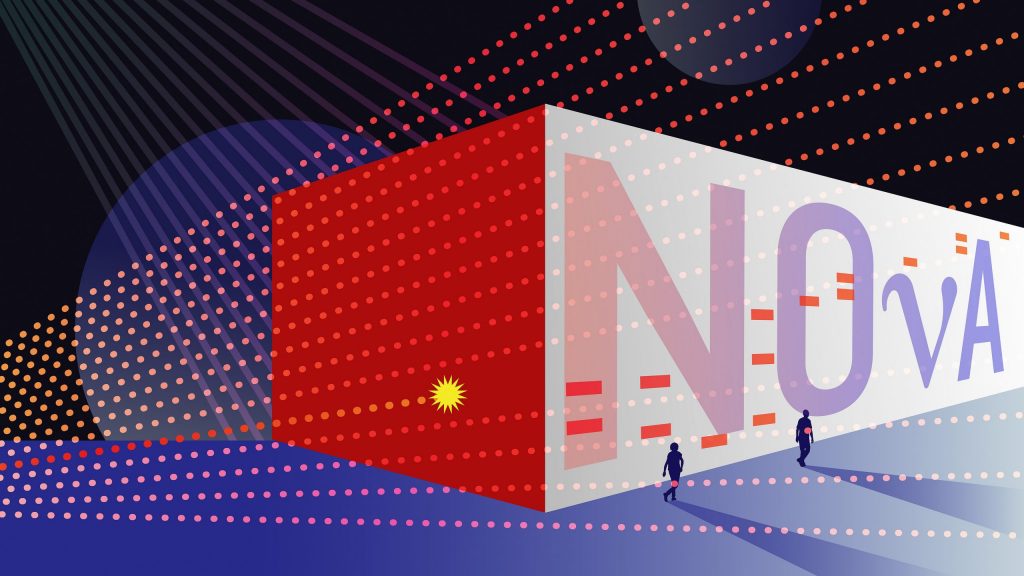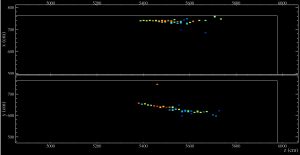
The Fermilab NOvA neutrino experiment announced that it has seen strong evidence of muon antineutrinos oscillating into electron antineutrinos over long distances, a phenomenon that has never been unambiguously observed. Image: Sandbox Studio
For more than three years, scientists on the NOvA collaboration have been observing particles called neutrinos as they oscillate from one type to another over a distance of 500 miles. Now, in a new result unveiled today at the Neutrino 2018 conference in Heidelberg, Germany, the collaboration has announced its first results using antineutrinos, and has seen strong evidence of muon antineutrinos oscillating into electron antineutrinos over long distances, a phenomenon that has never been unambiguously observed.
NOvA, based at the U.S. Department of Energy’s Fermi National Accelerator Laboratory, is the world’s longest-baseline neutrino experiment. Its purpose is to discover more about neutrinos, ghostly yet abundant particles that travel through matter mostly without leaving a trace. The experiment’s long-term goal is to look for similarities and differences in how neutrinos and antineutrinos change from one type — in this case, muon — into one of the other two types, electron or tau. Precisely measuring this change in both neutrinos and antineutrinos, and then comparing them, will help scientists unlock the secrets that these particles hold about how the universe operates.
NOvA uses two large particle detectors — a smaller one at Fermilab in Illinois and a much larger one 500 miles away in northern Minnesota — to study a beam of particles generated by Fermilab’s accelerator complex and sent through Earth, with no tunnel required.
The new result is drawn from NOvA’s first run with antineutrinos, the antimatter counterpart to neutrinos. NOvA began studying antineutrinos in February 2017. Fermilab’s accelerators create a beam of muon neutrinos (or muon antineutrinos), and NOvA’s far detector is specifically designed to see those particles changing into electron neutrinos (or electron antineutrinos) on their journey.
If antineutrinos did not oscillate from muon type to electron type, scientists would have expected to record just five electron antineutrino candidates in the NOvA far detector during this first run. But when they analyzed the data, they found 18, providing strong evidence that antineutrinos undergo this oscillation.
“Antineutrinos are more difficult to make than neutrinos, and they are less likely to interact in our detector,” said Fermilab’s Peter Shanahan, co-spokesperson of the NOvA collaboration. “This first data set is a fraction of our goal, but the number of oscillation events we see is far greater than we would expect if antineutrinos didn’t oscillate from muon type to electron. It demonstrates the impact that Fermilab’s high-power particle beam has on our ability to study neutrinos and antineutrinos.”
Although antineutrinos are known to oscillate, the change into electron antineutrinos over long distances has not yet been definitively observed. The T2K experiment, located in Japan, announced that it had observed hints of this phenomenon in 2017. The NOvA and T2K collaborations are working toward a combined analysis of their data in the coming years.

This display shows, from two perspectives, an electron antineutrino appearance candidate in the NOvA far detector. Image courtesy of Evan Niner/NOvA collaboration
“With this first result using antineutrinos, NOvA has moved into the next phase of its scientific program,” said Associate Director for High Energy Physics at the Department of Energy Office of Science Jim Siegrist. “I’m pleased to see this important experiment continuing to tell us more about these fascinating particles.”
NOvA’s new antineutrino result accompanies an improvement to its methods of analysis, leading to a more precise measurement of its neutrino data. From 2014 to 2017, NOvA saw 58 candidates for interactions from muon neutrinos changing into electron neutrinos, and scientists are using this data to move closer to unraveling some of the knottiest mysteries of these elusive particles.
The key to NOvA’s science program is comparing the rate at which electron neutrinos appear in the far detector with the rate that electron antineutrinos appear. A precise measurement of those differences will allow NOvA to achieve one of its main science goals: to determine which of the three types of neutrinos is the heaviest and which the lightest.
Neutrinos have been shown to have mass, but scientists have not been able to directly measure that mass. However, with enough data, they can determine the relative masses of the three, a puzzle called the mass ordering. NOvA is working toward a definitive answer to this question. Scientists on the experiment will continue studying antineutrinos through 2019 and, over the following years, will eventually collect equal amounts of data from neutrinos and antineutrinos.
“This first data set from antineutrinos is a just a start to what promises to be an exciting run,” said NOvA co-spokesperson Tricia Vahle of William & Mary. “It’s early days, but NOvA is already giving us new insights into the many mysteries of neutrinos and antineutrinos.”
For more information on neutrinos and neutrino research, please visit http://neutrinos.fnal.gov.
The NOvA collaboration includes more than 240 scientists from nearly 50 institutions in seven countries: Brazil, Colombia, Czech Republic, India, Russia, the UK and the United States. For more information visit the experiment’s website at http://novaexperiment.fnal.gov.
Fermilab is America’s premier national laboratory for particle physics and accelerator research. A U.S. Department of Energy Office of Science laboratory, Fermilab is located near Chicago, Illinois, and operated under contract by the Fermi Research Alliance LLC, a joint partnership between the University of Chicago and the Universities Research Association Inc. Visit Fermilab’s website at www.fnal.gov and follow us on Twitter at @Fermilab.
DOE’s Office of Science is the single largest supporter of basic research in the physical sciences in the United States, and is working to address some of the most pressing challenges of our time. For more information, please visit science.energy.gov.



